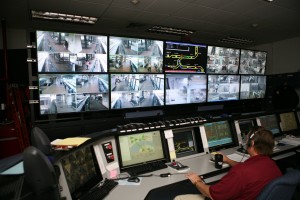
A fully integrated system revolutionizes transit security and surveillance
By Rodell Notbohm
Transit agencies across the nation are getting creative in their integration of proven technologies that include WiFi and cellular networks, GPS, smartphones, surveillance cameras, accelerometers, motion detectors and software to ensure passenger safety and decrease costs and legal liabilities. Call it a mash-up.
The typical city transit bus can have as many as 16 cameras on board to cover every angle inside and out to trigger an immediate response to any type of abnormal bus activity. An onboard disturbance or collision caught on camera can sound the alert at agency headquarters. A live video feed allows transit managers, first responders and law enforcement officials to view the scene from the bus cameras along with location mapping data synchronized with the video playback. The live video is even available on mobile phone apps.
Such highly sophisticated surveillance systems have essentially revolutionized the way agencies monitor performance, address safety needs and capture hard evidence for any pending litigation.
Capitalizing on federal grant funds, transit operations that have converted to digital video and high-performance mobile video surveillance systems include King County, Seattle, WA; Metro Transit, San Diego, CA; Metro Area Transit, Omaha, NB; and METRA, Chicago, IL.
Not your average surveillance
Jacksonville Transportation Authority (JTA), Jacksonville, FL, is successfully leveraging this combination of technologies to meet the needs of transit managers, and to provide surveillance access and coordination capabilities to first responders and law enforcement.
JTA envisioned a state-of-the-art command center for viewing and monitoring live video feeds from all stations and vehicles. The agency first equipped its fleet with digital video recorders (DVR) and four cameras strategically placed in the interior of each transit bus. These cameras provide video of passengers on-board as well as passengers entering and exiting the vehicles. Additionally, each station strategically positioned four to eight cameras feeding to facility-based DVRs to provide full surveillance.
Display monitors located in the command center provide a comprehensive view of the entire operation and enable transit managers to dispatch police immediately if safety or security concerns arise, including pedestrians crossing illegally into stations, jumping over gates, skipping fares, or participating in acts of vandalism and violence. The command center also provides access for instantly investigating passenger-reported incidents. The system allows law enforcement agencies to view real-time video from remote locations to ensure that security incidents are handled as quickly and safely as possible.
“Real-time video feeds have allowed us to not only prevent potential security and vandalism incidents, but also review any complaints that arise from commuters,” says Kenneth Williams, manager of JTA Skyway operations. “In a city the size of Jacksonville, safety and security remain our number one priority. Video surveillance solutions are key to addressing our concerns in these areas.”
To improve incident investigation, JTA installed video surveillance cameras with cellular and WiFi capabilities on buses, community shuttles and Skyway trains.
“We can now log on instantaneously and view incidents as they occur, or soon thereafter,” says Williams. “It is crucial that we have real-time viewing capabilities. When an incident occurs, or a bus operator is in need of assistance, we can now respond immediately and provide the necessary assistance to both operators and commuters.”
These capabilities also provide transit managers with up-to-date health notifications of the entire fleet. In addition to video surveillance capabilities, JTA’s control center is able to view real-time graphical route information and GPS data, identifying exactly where each bus is located. In the event of an emergency, the system provides bus operators with an incident switch that tags the event and provides instant access to live video of the incident.
“Video feeds are a crucial component of our monitoring and investigation processes,” says Williams. “The ability to log on remotely from either the command center or an off-site computer helps us ensure all commuters and transit personnel reach their destinations safely and on-time.”
Sophisticated investigation and evidence
Last year, JTA captured a critical incident on its digital video recording system. A camera installed on the exterior street side of a JTA bus allowed video footage of a bus rider struck by an oncoming vehicle as he was attempting to cross the street behind the bus. The video from this incident will undoubtedly be crucial in substantiating the information provided by those involved.
While this concept and these technologies are not new to the transit industry, installed in combination, they signal the next step toward more robust integrated security and surveillance systems that give transit managers the situational awareness they need to do their jobs. Mobile video surveillance delivers vital information and decisive video evidence -to transit managers wherever they are, reducing the time and costs associated with public transportation fleet management.
BIO: Rodell Notbohm serves as general manager, Apollo Video Technologies, Woodinville, WA, a manufacturer of on-board digital surveillance systems for public transit, school transportation and EMS applications.
